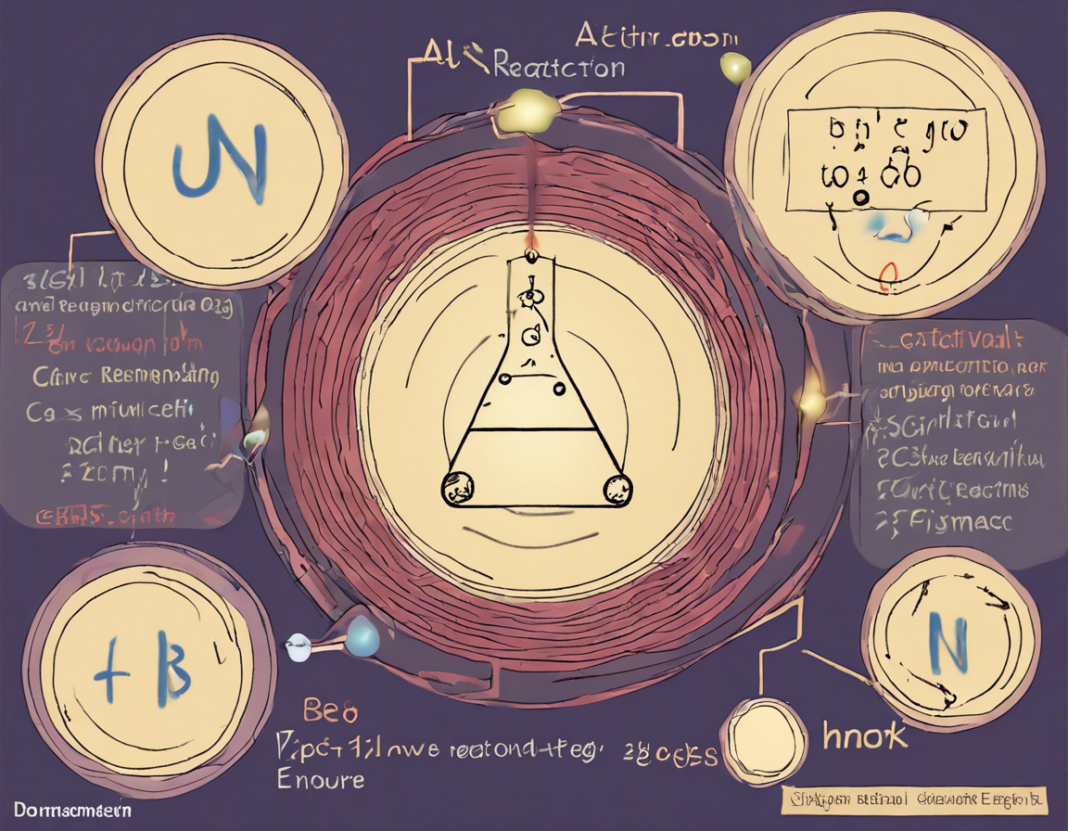Chemical reactions are a fundamental aspect of the natural world, playing a crucial role in various biological processes, industrial applications, and environmental changes. One key concept in the field of chemical kinetics is activation energy, which refers to the minimum amount of energy required to initiate a chemical reaction. In simple terms, reactions with a higher activation energy barrier proceed more slowly than those with a lower activation energy.
However, there is a fascinating phenomenon that challenges this conventional wisdom – the concept of zero activation energy. In traditional chemical kinetics, all reactions were assumed to have a non-zero activation energy, but recent research has uncovered certain reactions that seemingly defy this rule. In this article, we will explore the intriguing world of zero activation energy reactions, discussing their significance, implications, and potential applications.
Understanding Activation Energy
Before delving into the concept of zero activation energy, it is essential to grasp the basics of activation energy itself. In a chemical reaction, molecules must collide with sufficient energy and proper orientation to overcome the energy barrier known as the activation energy. This activation energy is crucial for breaking existing bonds and forming new ones, leading to the transformation of reactants into products.
The activation energy is often depicted in a reaction energy diagram, where the difference in energy between the reactants and the transition state represents the activation energy barrier. Higher activation energies correspond to slower reaction rates, as fewer collisions possess the necessary energy to overcome the barrier and proceed to product formation.
Zero Activation Energy: Myth or Reality?
Historically, all chemical reactions were assumed to involve a non-zero activation energy, as dictated by the principles of classical transition state theory. However, advancements in experimental techniques and theoretical models have challenged this long-standing belief, uncovering instances where reactions appear to occur without any discernible activation energy barrier.
In these scenarios, the reactions proceed at a rate that suggests the absence of an energy barrier, leading to the concept of zero activation energy. This phenomenon implies that the reactants spontaneously transform into products without the need for an external energy input to surmount an activation barrier. While counterintuitive from a traditional perspective, zero activation energy reactions have been observed in various systems, prompting researchers to reevaluate our understanding of reaction kinetics.
Mechanisms of Zero Activation Energy Reactions
The existence of zero activation energy reactions raises intriguing questions about the underlying mechanisms that drive such phenomenon. Several hypotheses and mechanisms have been proposed to explain how reactions can proceed with seemingly no activation energy barrier. Some of the prominent explanations include:
Quantum Tunneling
Quantum tunneling is a phenomenon rooted in quantum mechanics where particles penetrate through energy barriers that would be insurmountable in classical physics. In the context of chemical reactions, quantum tunneling allows particles to tunnel through the activation energy barrier, effectively bypassing the need for a traditional energy input. This mechanism is particularly prevalent in light atomic systems and low-temperature reactions.
Near-Barriorless Reactions
In certain cases, reactions may exhibit an extremely low activation energy that approaches zero. While not truly zero, the activation energy in these near-barrierless reactions is so minuscule that the reaction kinetics resemble those of zero activation energy reactions. Factors such as solvent effects, molecular symmetry, and resonance stabilization can contribute to lowering the activation energy to levels where it becomes almost negligible.
Coupled Energy Landscapes
Complex reactions involving multiple steps and intermediates can exhibit a collective energy landscape where the cumulative energy profile lacks a distinct activation energy barrier. In these coupled energy landscapes, the overall reaction pathway may involve a series of interconnected steps that collectively result in a seemingly barrierless transformation from reactants to products.
Applications of Zero Activation Energy Reactions
Zero activation energy reactions represent a paradigm shift in our understanding of reaction kinetics and offer exciting opportunities for various fields. Some potential applications of zero activation energy reactions include:
Green Chemistry
By enabling reactions to proceed without the need for high-energy inputs, zero activation energy pathways can pave the way for more sustainable and environmentally friendly chemical processes. Green chemistry principles prioritize efficiency, waste reduction, and resource conservation, making zero activation energy reactions attractive for developing greener synthetic routes.
Catalysis
Catalysts play a crucial role in lowering activation energies and facilitating reactions, but the concept of zero activation energy opens new avenues for catalytic strategies. Designing catalysts that harness quantum effects, exploit near-barrierless pathways, or optimize coupled energy landscapes could lead to innovative catalyst systems with enhanced efficiency and selectivity.
Energy Storage and Conversion
Zero activation energy reactions could revolutionize energy storage and conversion technologies by enabling faster and more efficient processes. Applications in batteries, fuel cells, and energy harvesting devices could benefit from reaction pathways that minimize energy losses associated with traditional activation barriers.
Challenges and Future Directions
While the concept of zero activation energy reactions holds immense promise, several challenges and uncertainties remain. Validating the existence of true zero activation energy reactions, distinguishing them from near-barrierless processes, and understanding the fundamental mechanisms driving these phenomena present ongoing research objectives for the scientific community.
Future studies utilizing advanced computational methods, ultrafast spectroscopy techniques, and precise kinetic measurements will be essential in unraveling the complexities of zero activation energy reactions. By elucidating the intricate dynamics of these unconventional pathways, researchers can unlock new insights into reaction mechanisms, energy landscapes, and the foundations of chemical reactivity.
Frequently Asked Questions (FAQs)
1. Can all reactions have zero activation energy?
No, while certain reactions may exhibit zero activation energy under specific conditions or mechanisms, not all reactions can inherently have zero activation energy. The concept of zero activation energy is relatively rare and often relies on unique circumstances or factors that enable reactions to proceed without a traditional energy barrier.
2. How do zero activation energy reactions challenge traditional chemical kinetics?
Zero activation energy reactions challenge the conventional understanding of reaction kinetics by suggesting that reactions can occur without a discernible energy barrier. This concept contradicts the classical transition state theory, which posits that all reactions involve an activation energy that must be overcome for the reaction to proceed.
3. What are some examples of zero activation energy reactions?
Examples of zero activation energy reactions include certain hydrogen exchange reactions, proton transfers in hydrogen-bonded systems, and enzymatic reactions where quantum tunneling plays a significant role. These systems exhibit reaction kinetics that imply the absence of a traditional activation energy barrier, highlighting the unique nature of zero activation energy phenomena.
4. How do zero activation energy reactions impact reaction rates?
Zero activation energy reactions typically exhibit faster reaction rates compared to reactions with higher activation energies. The absence of an energy barrier allows reactants to transform into products more readily, leading to accelerated kinetics and efficient product formation.
5. What are the implications of zero activation energy reactions for chemical synthesis?
In the context of chemical synthesis, zero activation energy reactions offer the potential for developing more efficient, sustainable, and cost-effective synthetic routes. Harnessing zero activation energy pathways could streamline reaction processes, reduce energy requirements, and enable the design of novel catalyst systems for targeted transformations.
6. How can researchers experimentally validate zero activation energy reactions?
Experimental validation of zero activation energy reactions often involves precise kinetic measurements, theoretical modeling, isotope labeling studies, and ultrafast spectroscopy techniques. By carefully characterizing the reaction kinetics, intermediates, and energy profiles, researchers can discern the presence of zero activation energy pathways and elucidate the underlying mechanisms driving these processes.
7. Are zero activation energy reactions limited to specific types of reactions or systems?
Zero activation energy reactions can manifest in a variety of reaction types and systems, ranging from simple bimolecular reactions to complex enzymatic processes. The occurrence of zero activation energy phenomena depends on factors such as molecular structure, environmental conditions, reaction mechanism, and energy landscape, showcasing the diverse contexts in which these reactions can arise.
8. What role does quantum mechanics play in zero activation energy reactions?
Quantum mechanics plays a pivotal role in elucidating the behavior of zero activation energy reactions, particularly through the phenomenon of quantum tunneling. Quantum effects such as tunneling allow particles to traverse energy barriers that would be insurmountable in classical mechanics, providing a mechanism for reactions to proceed without a traditional activation energy barrier.
9. How can zero activation energy reactions contribute to the field of energy storage?
Zero activation energy reactions hold potential applications in energy storage technologies by enabling efficient energy conversion and storage processes. In battery systems, for example, zero activation energy pathways could enhance charging and discharging rates, improve overall energy efficiency, and optimize the performance of energy storage devices.
10. What are the future prospects for exploring and harnessing zero activation energy reactions?
The future of zero activation energy reactions involves ongoing research efforts to deepen our understanding of these unconventional pathways and their implications for chemistry, physics, and materials science. By leveraging advanced experimental techniques, computational methods, and theoretical insights, researchers aim to unlock the full potential of zero activation energy reactions in diverse fields and applications.
In conclusion, zero activation energy reactions represent a captivating frontier in the realm of chemical kinetics, challenging established norms and opening new possibilities for understanding and manipulating reaction dynamics. By embracing the complexities of zero activation energy phenomena, researchers can illuminate the underlying mechanisms of these unconventional pathways and leverage their potential for innovation, sustainability, and scientific advancement.






